
Zork is a text-based adventure game first released in 1977 by developers Tim Anderson, Marc Blank, Bruce Daniels, and Dave Lebling for the PDP-10 mainframe computer. The original developers and others, as the company Infocom, expanded and split the game into three titles—Zork I: The Great Underground Empire, Zork II: The Wizard of Frobozz, and Zork III: The Dungeon Master—which were released commercially for a range of personal computers beginning in 1980. In Zork, the player explores the abandoned Great Underground Empire in search of treasure. The player moves between the game's hundreds of locations and interacts with objects by typing commands in natural language that the game interprets. The program acts as a narrator, describing the player's location and the results of the player's commands. It has been described as the most famous piece of interactive fiction.

Bloodwych is a dungeon role-playing video game, a dungeon crawler, developed for the Amiga, Atari ST, MS-DOS, Amstrad CPC, Commodore 64, and ZX Spectrum. Its box featured artwork by Chris Achilleos. The plotline identifies the player as a champion of Trazere who, after recruiting up to three fellow champions, travels through dungeons and mazes fighting creatures along the way to find and destroy the evil Zendick, and banish the Lord of Entropy.

Pool of Radiance is a role-playing video game developed and published by Strategic Simulations, Inc (SSI) in 1988. It was the first adaptation of TSR's Advanced Dungeons & Dragons (AD&D) fantasy role-playing game for home computers, becoming the first episode in a four-part series of D&D computer adventure games. The other games in the "Gold Box" series used the game engine pioneered in Pool of Radiance, as did later D&D titles such as the Neverwinter Nights online game. Pool of Radiance takes place in the Forgotten Realms fantasy setting, with the action centered in and around the port city of Phlan.
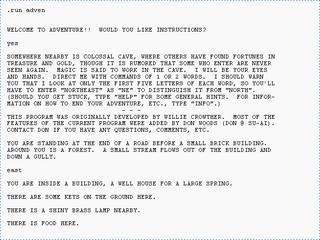
Colossal Cave Adventure is a text-based adventure game, released in 1976 by developer Will Crowther for the PDP-10 mainframe computer. It was expanded upon in 1977 by Don Woods. In the game, the player explores a cave system rumored to be filled with treasure and gold. The game is composed of dozens of locations, and the player moves between these locations and interacts with objects in them by typing one- or two-word commands which are interpreted by the game's natural language input system. The program acts as a narrator, describing the player's location and the results of the player's attempted actions. It is the first well-known example of interactive fiction, as well as the first well-known adventure game, for which it was also the namesake.
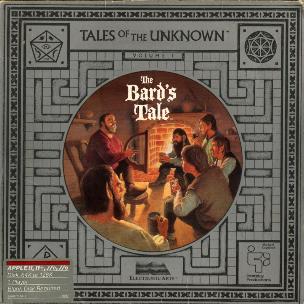
The Bard's Tale is a fantasy role-playing video game designed and programmed by Michael Cranford for the Apple II. It was produced by Interplay Productions in 1985 and distributed by Electronic Arts. The game was ported to the Commodore 64, Apple IIGS, ZX Spectrum, Amstrad CPC, Amiga, Atari ST, DOS, Macintosh, and NES. It spawned The Bard's Tale series of games and books. The earliest editions of the game used a series title of Tales of the Unknown, but this title was dropped for later ports of The Bard's Tale and subsequent games in the series.
The magic in Dungeons & Dragons consists of the spells and magic systems used in the settings of the role-playing game Dungeons & Dragons (D&D). D&D defined the genre of fantasy role-playing games, and remains the most popular table-top version. Many of the original concepts have become widely used in the role-playing community across many different fictional worlds, as well as across all manner of popular media including books, board games, video games, and films.
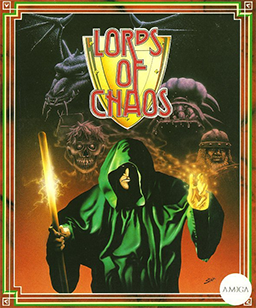
Lords of Chaos is a turn-based tactics tactical role-playing game published by Blade Software in 1990. It is the sequel to Chaos and an ancestor of the popular X-COM series of games, also written by Julian Gollop. In Lords of Chaos each player controls a wizard who can cast various magic spells. The spells have various effects, for example summoning other creatures, or damaging opposing creatures and wizards. The game can be played against a computer-controlled opponent or by up to four human players.

Odyssey: The Compleat Apventure was a video game written by Robert Clardy and released by Synergistic Software in 1980. It was created for the Apple II platform and is considered one of the first microcomputer-based role-playing video games. The title was intentionally misspelled; Apventure is a reference to the Apple computer while "Compleat" is simply an Archaic spelling of the word "complete" meant to match the feel and setting of the game.

Journey: The Quest Begins is an interactive fiction computer game designed by Marc Blank, with illustrations by Donald Langosy, and released by Infocom in 1989. Like the majority of Infocom's works, it was released simultaneously for several popular computer platforms, such as the Commodore 64, Apple II, and PC. Journey is unusual among Infocom games in that it could be played entirely via mouse or joystick, with no typing required. It was the thirty-fifth and last game released by Infocom before parent company Activision closed the Cambridge office, effectively reducing Infocom to a "label" to be applied to later games.
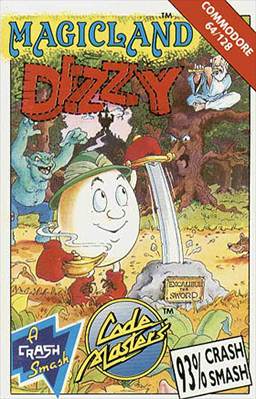
Magicland Dizzy is a platform adventure game published in Europe in 1990 by Codemasters for the ZX Spectrum, Commodore 64 and Amiga platforms. By 1992 there were also MS-DOS, Atari ST and Amstrad CPC versions available. It is the sixth game in the Dizzy series, and the fourth adventure-based Dizzy title. The story, set in a fantasy world called Magicland, follows on from the events of Fantasy World Dizzy, the previous adventure title. In Magicland Dizzy the player controls Dizzy, an egg-shaped character, who is trying to save six of his friends who have been placed under spells by the Evil Wizard Zaks.
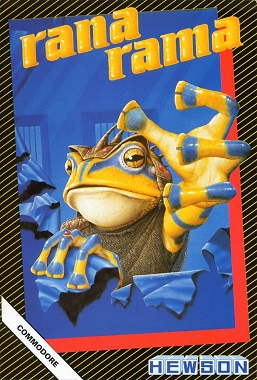
Ranarama is a top-down Gauntlet-like action game developed by Graftgold and published by Hewson Consultants in 1987. It was released for the Amstrad CPC, Atari ST, Commodore 64 and ZX Spectrum home computers. The title appears to be a pun on rana, a genus of frogs. The game concept is similar to a previous game by Steve Turner for the ZX Spectrum called Quazatron, which was itself inspired by Paradroid, created by Turner's Graftgold colleague Andrew Braybrook.

The Immortal is an isometric action-adventure game originally created by Will Harvey and released by Electronic Arts in 1990 for the Apple IIGS. It was soon ported to the Amiga, Atari ST, DOS, Nintendo Entertainment System, and Genesis. A wizard is attempting to find his mentor in a large and dangerous labyrinth. It has a high degree of graphic violence. In 2020, the NES port was re-released on the Nintendo Switch Online service, while the Genesis port was re-released on the Piko Collection Collection 1 cartridge for the Evercade.

Dungeon! is an adventure board game designed by David R. Megarry and first released by TSR, Inc. in 1975. Additional contributions through multiple editions were made by Gary Gygax, Steve Winter, Jeff Grubb, Chris Dupuis and Michael Gray. Dungeon! simulates some aspects of the Dungeons & Dragons (D&D) role-playing game, which was released in 1974, although Megarry had a prototype of Dungeon! ready as early as 1972.
Dungeon Scroll is a video game released by Robinson Technologies. It was originally released for the PC in 2003 with a Gold edition of the game being released in November 2005. In 2009, a mobile version of the game was released for the iPhone, followed up by releases the next year for the Android and Palm devices. The PC version was an Independent Games Festival finalist at the 2004 Game Developers Conference.

Aztec Challenge refers to either of two early action video games published by COSMI, as well as two subsequent remakes. In all game versions the player takes control of a running Aztec warrior. The first was a side-scrolling platform-jumping game created by Robert Tegel Bonifacio and released in 1982 for the Atari 8-bit family. Subsequently, a different game with the same title and overall theme was created by Paul Norman and released for the Commodore 64. It includes a level in a modified-first-person 3D-style.

Barbarian II: The Dungeon of Drax is a video game first published in 1988 for various home computers. It was released as Axe of Rage in North America. The game is the sequel to Barbarian: The Ultimate Warrior, which was published in 1987. In Barbarian II, the player controls a princess or barbarian character, exploring the game world to locate and defeat an evil wizard. The game's plot is an extension of its predecessor, although the gameplay is different. While the first game offers two players the opportunity for virtual head-to-head combat, the second is a single-player beat 'em up with fewer fighting moves. It uses a flip-screen style instead of scrolling.
Pool of Radiance is a series of role-playing video games set in the Forgotten Realms campaign settings of Dungeons & Dragons; it was the first Dungeons & Dragons video game series to be based on the Advanced Dungeons & Dragons rules.

Hero of the Golden Talisman is an action-adventure video game developed by British studio Mr Chip Software and published by Mastertronic in 1985 for the Commodore 64. A port to the Amstrad CPC followed. It is an early example of the Metroidvania style, despite preceding both of the genre's namesakes.

Doriath is a side-view action-adventure platform game released for the Commodore 64 in 1985.
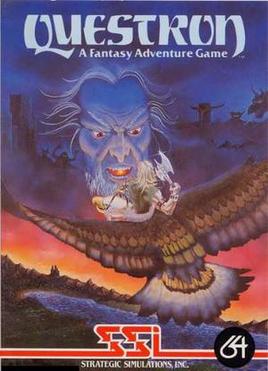
Questron is a 1984 game from Strategic Simulations, the first fantasy title from a company known for computer wargames. It was written by Charles Dougherty and Gerald Wieczorek and released for the Apple II, Atari 8-bit family, and Commodore 64. A sequel, Questron II, was released in 1988.

















